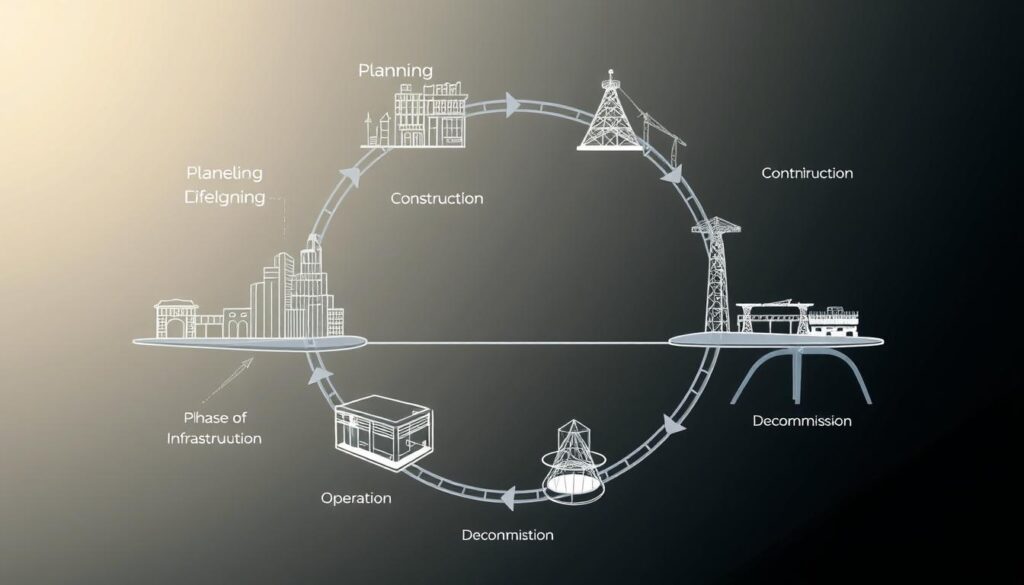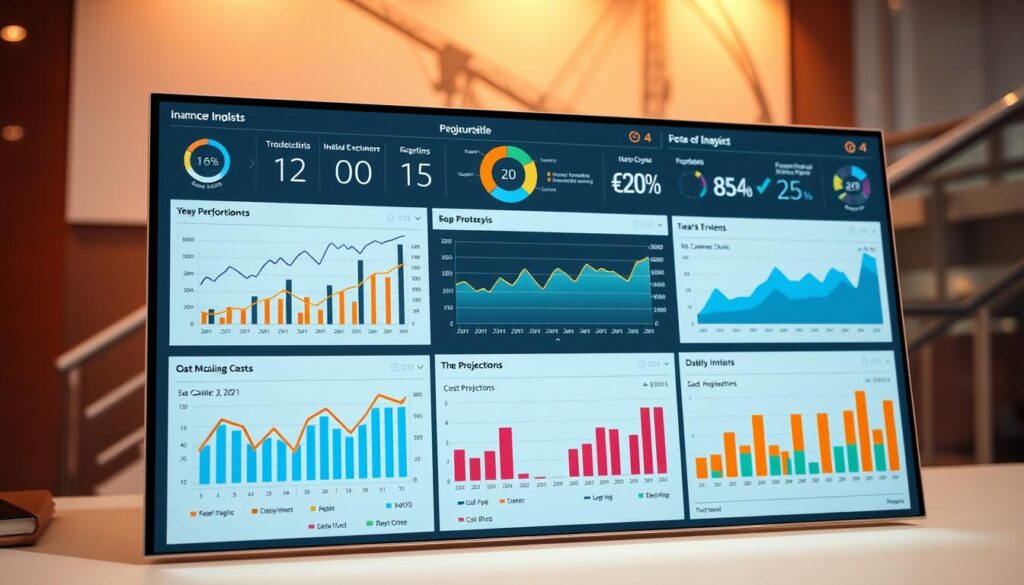Are you aware of the long-term implications of your infrastructure projects? From initial planning to maintenance, understanding the entire lifecycle is crucial for economic viability, environmental sustainability, and social benefit.
Infrastructure Lifecycle Analysis (ILCA) is a comprehensive approach that assesses projects from cradle to maintenance, ensuring that they meet these critical criteria. By adopting ILCA, stakeholders can make informed decisions that impact the project’s overall success.
Effective asset management strategies are integral to ILCA, enabling the optimization of resources and minimizing risks associated with infrastructure development.
Key Takeaways
- Understanding the importance of ILCA in infrastructure development.
- Recognizing the role of asset management strategies in ILCA.
- Identifying the benefits of adopting a comprehensive ILCA approach.
- Learning how ILCA contributes to sustainable and resilient infrastructure.
- Appreciating the long-term implications of ILCA on project success.
What is Infrastructure Lifecycle Analysis?
Infrastructure Lifecycle Analysis (ILCA) is a comprehensive methodology that evaluates the environmental, social, and economic impacts of infrastructure projects throughout their entire lifespan. This approach is crucial for sustainable development, as it considers the long-term effects and benefits of infrastructure projects.
Definition and Importance
ILCA is defined as a systematic process that assesses the various stages of infrastructure development, from planning and construction to operation and decommissioning. The importance of ILCA lies in its ability to provide stakeholders with a holistic view of infrastructure projects, enabling them to make informed decisions that balance economic, social, and environmental considerations.
The use of maintenance optimization techniques is a key aspect of ILCA, as it helps in reducing costs and improving the efficiency of infrastructure management. Additionally, infrastructure monitoring tools play a vital role in ILCA by providing real-time data on the condition and performance of infrastructure assets.
Key Components and Phases
The key components of ILCA include data collection, impact assessment, and decision-making. The process involves several phases:
- Planning and development
- Construction and implementation
- Operation and maintenance
- Decommissioning and renewal
Each phase is critical and contributes to the overall lifecycle analysis. A comprehensive understanding of these phases is essential for effective ILCA.
To illustrate the process, consider the following table that outlines the key activities and outcomes of each phase:
| Phase | Key Activities | Outcomes |
|---|---|---|
| Planning and Development | Feasibility studies, design, and budgeting | Project plans, budget allocations |
| Construction and Implementation | Site preparation, construction, and testing | Completed infrastructure, initial performance data |
| Operation and Maintenance | Monitoring, maintenance, and repair | Ongoing performance data, maintenance records |
| Decommissioning and Renewal | Assessment, decommissioning, and renewal planning | Decommissioning reports, plans for renewal or replacement |
The Phases of Infrastructure Lifecycle

Infrastructure lifecycle analysis involves a thorough examination of various stages, from planning to decommissioning. This comprehensive approach ensures that all aspects of infrastructure development and management are considered, leading to more sustainable and effective projects.
Planning and Development
The initial phase of infrastructure lifecycle is planning and development. This stage involves feasibility studies, design, and permitting. Effective planning sets the foundation for the project’s success by identifying potential risks and opportunities. It is during this phase that performance assessment methodologies are first considered, laying the groundwork for future evaluations.
Operation and Maintenance
Once the infrastructure is developed, it enters the operation and maintenance phase. This stage is critical for ensuring the infrastructure continues to function as intended. Regular maintenance activities and performance monitoring are essential. The data collected during this phase informs infrastructure renewal planning by highlighting areas that may require upgrade or replacement.
Decommissioning and Renewal
The final phase involves decommissioning and renewal. As infrastructure reaches the end of its lifecycle, decisions must be made regarding its replacement or renewal. This phase requires careful planning to minimize disruption and ensure that new infrastructure meets current and future needs. Infrastructure renewal planning is crucial here, as it involves assessing the condition of existing infrastructure and determining the most effective strategies for its renewal.
Understanding these phases and their interconnections is vital for effective infrastructure lifecycle analysis. By considering the entire lifecycle, stakeholders can make informed decisions that enhance the sustainability and efficiency of infrastructure projects.
The Benefits of Conducting Lifecycle Analysis
Infrastructure lifecycle analysis offers a comprehensive approach to understanding and optimizing infrastructure projects. By examining the entire lifecycle of infrastructure assets, organizations can make informed decisions that impact cost, efficiency, and sustainability.
Cost Efficiency
One of the primary benefits of lifecycle analysis is cost efficiency. Through lifecycle cost analysis, organizations can predict and manage costs more effectively, reducing the financial burden of infrastructure projects. This involves:
- Identifying potential cost savings through efficient design and material selection.
- Optimizing maintenance schedules to extend the lifespan of infrastructure assets.
- Implementing cost-effective strategies for decommissioning and renewal.
Improved Resource Management
Lifecycle analysis also enables improved resource management. By understanding the lifecycle needs of infrastructure assets, organizations can allocate resources more effectively, ensuring that assets are utilized to their full potential. This includes:
- Enhancing infrastructure asset tracking to monitor asset condition and performance.
- Optimizing resource allocation for maintenance and operations.
- Reducing waste and improving the overall efficiency of infrastructure projects.
Enhanced Sustainability
Furthermore, lifecycle analysis contributes to enhanced sustainability. By considering the environmental impacts throughout the lifecycle of infrastructure assets, organizations can adopt more sustainable practices, reducing their ecological footprint. Key strategies include:
- Selecting materials and designs that minimize environmental impact.
- Implementing sustainable maintenance and operation practices.
- Planning for the eventual decommissioning and recycling of infrastructure assets.
In conclusion, conducting lifecycle analysis provides numerous benefits, including cost efficiency, improved resource management, and enhanced sustainability. By adopting this comprehensive approach, organizations can optimize their infrastructure projects, achieving better outcomes for both their operations and the environment.
Challenges in Infrastructure Lifecycle Analysis

Despite its benefits, ILCA faces numerous challenges that need to be addressed for successful implementation. One of the primary difficulties is ensuring the accuracy and comprehensiveness of the data collected during the analysis process.
Data Collection Issues
Data collection is a critical component of ILCA, as it relies heavily on condition assessment methods to evaluate the state of infrastructure. However, gathering accurate and comprehensive data can be challenging due to factors such as aging infrastructure, lack of standardized data collection protocols, and limited access to certain areas.
“The accuracy of ILCA is directly dependent on the quality of data collected,” as noted by industry experts. Therefore, it is essential to implement robust data collection strategies to overcome these challenges.
Stakeholder Engagement
Effective stakeholder engagement is another significant challenge in ILCA. It requires the involvement of various stakeholders, including government agencies, private investors, and local communities. Ensuring that all stakeholders are aligned with the goals and objectives of the ILCA can be difficult, but it is crucial for its success.
- Identifying key stakeholders and their interests
- Developing effective communication strategies
- Facilitating workshops and feedback sessions
Regulatory Compliance
ILCA must also comply with a myriad of regulatory requirements, which can vary significantly across different jurisdictions. Ensuring compliance with these regulations while conducting a thorough lifecycle analysis can be complex and time-consuming.
As stated by a regulatory body, “Compliance with regulatory standards is not just a legal necessity but also a critical factor in ensuring the sustainability and safety of infrastructure projects.”
In conclusion, while ILCA offers numerous benefits, it is not without its challenges. Addressing these challenges effectively is crucial for the successful implementation of ILCA.
Best Practices for Infrastructure Lifecycle Analysis
To achieve successful infrastructure lifecycle analysis, several best practices must be adopted. Infrastructure lifecycle analysis is a critical component of asset management strategies, enabling organizations to optimize their infrastructure projects.
One of the key best practices is comprehensive data collection. Gathering accurate and detailed data on the infrastructure’s condition, performance, and maintenance history is essential for making informed decisions. This data can be used to identify potential issues, predict future problems, and develop effective maintenance strategies.
Comprehensive Data Collection
Comprehensive data collection involves gathering data from various sources, including sensors, inspection reports, and maintenance records. This data should be stored in a centralized database, making it easily accessible to stakeholders. By leveraging advanced data analytics tools, organizations can gain valuable insights into their infrastructure’s performance and make data-driven decisions.
For instance, the use of digital twins and simulation models can enhance the accuracy of infrastructure lifecycle analysis. As discussed in the article on how AI is transforming civil engineering, the integration of AI and machine learning can significantly improve the analysis process.
Stakeholder Involvement
Another crucial best practice is stakeholder involvement. Engaging stakeholders throughout the infrastructure lifecycle analysis process ensures that their needs and concerns are addressed. This includes identifying key stakeholders, communicating effectively with them, and incorporating their feedback into the analysis.
Effective stakeholder involvement can lead to better decision-making, improved project outcomes, and increased stakeholder satisfaction. By fostering a collaborative environment, organizations can ensure that their infrastructure lifecycle analysis is comprehensive and effective.
Regular Reviews and Updates
Regular reviews and updates are also essential for ensuring the accuracy and relevance of the infrastructure lifecycle analysis. As infrastructure projects evolve, new data becomes available, and stakeholder needs change, the analysis must be updated to reflect these changes.
By adopting these best practices, organizations can optimize their infrastructure lifecycle analysis, leading to improved asset management strategies and better project outcomes.
Tools and Software for Lifecycle Analysis

Advanced tools and software play a pivotal role in optimizing infrastructure lifecycle analysis. By leveraging these technologies, organizations can streamline their processes, improve accuracy, and make informed decisions.
The use of specialized tools and software is crucial in managing the complexities of infrastructure lifecycle analysis. These solutions enable the efficient collection, analysis, and interpretation of data, which are essential for effective decision-making.
Asset Management Software
Asset management software is a critical component in lifecycle analysis, enabling organizations to track and manage their assets throughout their entire lifecycle. This software provides a centralized platform for storing and analyzing asset data, facilitating maintenance optimization techniques and infrastructure monitoring.
Some of the key features of asset management software include:
- Asset tracking and inventory management
- Maintenance scheduling and work order management
- Condition monitoring and reporting
- Integration with other systems, such as ERP and CMMS
Lifecycle Simulation Tools
Lifecycle simulation tools allow organizations to model and simulate various lifecycle scenarios, enabling them to predict and analyze the potential outcomes of different decisions. These tools are particularly useful for evaluating the long-term implications of infrastructure investments.
The benefits of lifecycle simulation tools include:
- Enhanced decision-making through data-driven insights
- Improved risk management through scenario planning
- Optimization of lifecycle costs and performance
Data Analysis Platforms
Data analysis platforms are essential for processing and analyzing the vast amounts of data generated during lifecycle analysis. These platforms provide advanced analytics capabilities, enabling organizations to uncover valuable insights and trends.
Some of the key features of data analysis platforms include:
- Data integration and processing
- Advanced analytics and modeling
- Data visualization and reporting
The following table summarizes the key tools and software used in lifecycle analysis:
| Tool/Software | Description | Benefits |
|---|---|---|
| Asset Management Software | Centralized platform for asset data management | Improved asset tracking, maintenance optimization |
| Lifecycle Simulation Tools | Modeling and simulation of lifecycle scenarios | Enhanced decision-making, risk management |
| Data Analysis Platforms | Advanced analytics for lifecycle data | Data-driven insights, trend analysis |
Case Studies of Effective Lifecycle Analysis
Real-world examples illustrate the effectiveness of infrastructure lifecycle analysis in enhancing project outcomes. By examining various case studies, we can gain insights into how different sectors have successfully applied lifecycle analysis to improve their infrastructure projects.
Transportation Infrastructure
The transportation sector has seen significant benefits from lifecycle analysis. For instance, a study on highway infrastructure revealed that regular maintenance and timely renewal planning can reduce long-term costs by up to 30%. Performance assessment methodologies played a crucial role in identifying areas that required immediate attention, thereby enhancing the overall efficiency of the transportation network.
A notable example is the renovation of a major highway interchange, where lifecycle analysis helped in planning and executing a phased construction process, minimizing disruptions to traffic flow. This project demonstrated the importance of infrastructure renewal planning in maintaining the integrity and functionality of critical transportation infrastructure.
Energy Sector Projects
In the energy sector, lifecycle analysis has been instrumental in optimizing the performance and longevity of power generation and transmission infrastructure. A case study on a wind farm project showed that by applying lifecycle analysis, the operators could predict and prevent potential equipment failures, thereby reducing downtime and increasing overall energy output.
| Project Component | Lifecycle Analysis Benefit | Outcome |
|---|---|---|
| Wind Turbines | Predictive Maintenance | Reduced Downtime |
| Transmission Lines | Regular Inspection Scheduling | Enhanced Reliability |
Urban Development Examples
Urban development projects have also benefited from the application of lifecycle analysis. A city planning initiative used lifecycle analysis to assess the long-term sustainability of new residential and commercial developments. By evaluating factors such as energy efficiency, water usage, and waste management, the city was able to make informed decisions that minimized environmental impact while maximizing economic benefits.
- Improved energy efficiency through green building practices
- Enhanced water management systems
- Effective waste reduction and recycling programs
These case studies underscore the value of infrastructure lifecycle analysis in driving sustainable and efficient infrastructure development across various sectors.
The Role of Technology in Lifecycle Analysis

Infrastructure lifecycle analysis has become more efficient with the advent of cutting-edge technologies like digital twins and IoT. These advancements are transforming the way infrastructure assets are managed and maintained throughout their lifecycle.
Digital Twins and Simulation
Digital twins are virtual replicas of physical infrastructure assets, allowing for real-time monitoring and simulation. This technology enables asset managers to predict potential failures and optimize maintenance schedules. Simulation capabilities also facilitate the testing of various scenarios, reducing the risk of costly repairs and improving overall asset resilience.
- Enhanced predictive maintenance
- Improved asset performance
- Reduced operational costs
IoT and Data Analytics
The Internet of Things (IoT) plays a crucial role in infrastructure lifecycle analysis by providing real-time data on asset conditions. IoT sensors can monitor temperature, vibration, and other critical parameters, feeding data into analytics platforms. This data is then analyzed to identify trends and potential issues, enabling proactive maintenance and reducing downtime.
Predictive Maintenance Technologies
Predictive maintenance technologies leverage data analytics and machine learning algorithms to forecast potential asset failures. By analyzing historical data and real-time sensor readings, these systems can identify early warning signs of deterioration. This enables maintenance teams to address issues before they become critical, minimizing disruptions and extending the lifespan of infrastructure assets.
- Predictive modeling
- Condition-based maintenance
- Risk-based inspection
By integrating these technologies, infrastructure managers can achieve more efficient lifecycle cost analysis and improve infrastructure asset tracking. The result is a more resilient and sustainable infrastructure ecosystem.
Regulatory Considerations in Lifecycle Analysis
Infrastructure lifecycle analysis is heavily influenced by regulatory considerations, including federal and state guidelines, environmental regulations, and safety standards. These regulations play a crucial role in shaping the development, operation, and decommissioning of infrastructure projects.
Federal and State Guidelines
Federal and state guidelines provide a framework for infrastructure development, ensuring that projects are designed and executed in a manner that minimizes risk and maximizes efficiency. Compliance with these guidelines is essential for avoiding legal and financial repercussions. For instance, the life cycle assessment (LCA) guide provides insights into how infrastructure projects can be evaluated over their entire lifecycle, aligning with federal and state regulations.
Some key aspects of federal and state guidelines include:
- Design and construction standards
- Environmental impact assessments
- Public consultation requirements
Environmental Regulations
Environmental regulations are critical in ensuring that infrastructure projects do not harm the environment. These regulations cover a wide range of areas, including air and water quality, habitat preservation, and waste management. Effective condition assessment methods are vital in this context, as they help in identifying potential environmental risks associated with infrastructure projects.
Key environmental regulations include:
- The Clean Air Act
- The Clean Water Act
- The Endangered Species Act
Safety Standards
Safety standards are another crucial aspect of regulatory considerations in lifecycle analysis. These standards are designed to protect workers, users, and the general public from potential hazards associated with infrastructure projects. Compliance with safety standards is not only a legal requirement but also essential for maintaining public trust and avoiding costly accidents.
Some key safety standards include:
- Occupational Safety and Health Administration (OSHA) regulations
- American Society of Civil Engineers (ASCE) standards
- National Highway Traffic Safety Administration (NHTSA) guidelines
By understanding and complying with these regulatory considerations, infrastructure stakeholders can ensure that their projects are not only legally compliant but also sustainable, safe, and efficient.
Future Trends in Infrastructure Lifecycle Analysis

As we look ahead, infrastructure lifecycle analysis is set to be revolutionized by emerging trends that prioritize sustainability and technological innovation. The integration of advanced technologies and sustainable practices is transforming the way infrastructure projects are planned, executed, and maintained.
Sustainability and Green Infrastructure
The focus on sustainability is becoming increasingly prominent in infrastructure lifecycle analysis. Green infrastructure, which includes sustainable materials, energy-efficient systems, and eco-friendly designs, is gaining traction. This shift is driven by the need to reduce environmental impact and comply with stringent regulations. For instance, the use of recycled materials in construction projects not only reduces waste but also lowers the carbon footprint associated with producing new materials.
According to a report by the World Civil Society, incorporating green infrastructure can significantly enhance the resilience of infrastructure projects, making them more adaptable to climate change and other environmental challenges.
Integration of AI and Machine Learning
The integration of AI and machine learning into infrastructure lifecycle analysis is another significant trend. These technologies enable more accurate predictive modeling, allowing for better decision-making throughout the lifecycle of infrastructure projects. AI-driven analytics can process vast amounts of data to identify patterns and predict potential issues before they arise, thereby reducing maintenance costs and improving asset management strategies.
- Predictive maintenance scheduling
- Enhanced data analysis for decision-making
- Improved risk assessment and management
For more insights on how AI is transforming infrastructure management, visit Encardio’s blog on infrastructure lifecycle analysis.
Remote Monitoring Technologies
Remote monitoring technologies are also playing a crucial role in the future of infrastructure lifecycle analysis. These technologies allow for real-time monitoring of infrastructure conditions, enabling proactive maintenance and reducing the need for physical inspections. Remote sensing technologies, IoT devices, and other monitoring tools provide valuable data that can be used to optimize maintenance schedules and improve overall asset performance.
“The adoption of remote monitoring technologies is revolutionizing the way we manage infrastructure, enabling more efficient and effective maintenance practices.”
As infrastructure lifecycle analysis continues to evolve, the adoption of these trends will be crucial in shaping the future of infrastructure management. By embracing sustainability, leveraging AI and machine learning, and utilizing remote monitoring technologies, stakeholders can ensure that infrastructure projects are more resilient, efficient, and environmentally friendly.
Engaging Stakeholders in the Analysis Process
The success of infrastructure lifecycle analysis heavily relies on the active engagement of stakeholders. Engaging stakeholders is critical in ensuring that all aspects of the infrastructure lifecycle are considered, from planning and development to operation and maintenance.
Identifying Key Stakeholders
Identifying key stakeholders is the first step in the stakeholder engagement process. This involves recognizing individuals and groups who have a vested interest in the infrastructure project. Key stakeholders may include government agencies, local communities, contractors, and maintenance personnel. Effective identification of stakeholders is crucial for the successful implementation of maintenance optimization techniques.
A thorough stakeholder analysis can be conducted using various methods, including surveys, interviews, and stakeholder mapping. For more information on stakeholder analysis, you can refer to resources such as stakeholder analysis guides.
Communication Strategies
Effective communication is vital for successful stakeholder engagement. It involves conveying project information clearly and transparently to all stakeholders. Various communication strategies can be employed, including regular updates, public meetings, and digital communication platforms.
- Regular newsletters to keep stakeholders informed about project progress.
- Public meetings to address concerns and gather feedback.
- Digital platforms for real-time updates and stakeholder engagement.
Workshops and Feedback Sessions
Workshops and feedback sessions are essential components of the stakeholder engagement process. These forums provide stakeholders with the opportunity to contribute to the decision-making process and offer valuable insights.
Conducting workshops and feedback sessions can help in identifying potential issues early on and foster a collaborative environment. It is also an effective way to validate the effectiveness of maintenance optimization techniques and other project strategies.
By engaging stakeholders effectively, infrastructure lifecycle analysis can be more comprehensive and accurate, ultimately leading to better project outcomes.
The Economic Impact of Infrastructure Lifecycle Analysis

Understanding the economic impact of infrastructure lifecycle analysis is crucial for making informed decisions about infrastructure projects. Infrastructure lifecycle analysis provides a comprehensive framework for evaluating the economic implications of infrastructure projects, from initial planning to decommissioning.
Cost-Benefit Analysis
A critical component of infrastructure lifecycle analysis is cost-benefit analysis. This involves evaluating the total costs associated with an infrastructure project, including initial investment, operation, maintenance, and eventual decommissioning, against the benefits it provides. By conducting a thorough cost-benefit analysis, stakeholders can determine whether a project is economically viable and identify areas where costs can be optimized.
- Initial Investment Costs: Understanding the upfront costs associated with infrastructure projects.
- Ongoing Maintenance Costs: Evaluating the costs required to maintain the infrastructure over its lifecycle.
- Economic Benefits: Assessing the economic benefits generated by the infrastructure, such as increased productivity or job creation.
Long-term Investment Savings
Infrastructure lifecycle analysis also helps in identifying long-term investment savings. By understanding the lifecycle costs of infrastructure, organizations can make more informed decisions about investments, potentially leading to significant savings over the project’s lifetime. This proactive approach to cost management can help in avoiding costly repairs or premature replacements.
Some of the ways lifecycle analysis contributes to long-term savings include:
- Predictive maintenance, which reduces the likelihood of costly failures.
- Optimized resource allocation, ensuring that resources are used efficiently throughout the project’s lifecycle.
- Extended asset lifespan, achieved through proper maintenance and timely upgrades.
Enhancing Community Resilience
Infrastructure lifecycle analysis plays a vital role in enhancing community resilience. By ensuring that infrastructure is designed and maintained to withstand potential disruptions, communities can reduce the risk of infrastructure failures during natural disasters or other crises. This not only saves costs in the long run but also protects the well-being of community members.
Key strategies for enhancing community resilience through lifecycle analysis include:
- Risk Assessment: Identifying potential risks and vulnerabilities in infrastructure.
- Adaptive Planning: Developing plans that can adapt to changing conditions and unexpected events.
- Community Engagement: Engaging with the community to understand their needs and priorities.
Conclusion: The Importance of Infrastructure Lifecycle Analysis
Infrastructure lifecycle analysis is a critical methodology for ensuring the sustainability and resilience of infrastructure development projects. By understanding the various phases of the infrastructure lifecycle, stakeholders can make informed decisions that impact the long-term viability of their projects.
The use of digital twins and condition assessment methods can significantly enhance the efficiency and effectiveness of infrastructure lifecycle analysis. As organizations continue to adopt these approaches, they will be better equipped to manage the complexities of modern infrastructure development.
Key Takeaways and Future Directions
The key takeaways from this guide emphasize the importance of a comprehensive approach to infrastructure lifecycle analysis. Stakeholders must consider the entire lifecycle, from planning and development to operation and maintenance, to ensure the long-term success of their projects.
As the infrastructure landscape continues to evolve, it is essential for stakeholders to adopt innovative approaches, such as digital twins and advanced condition assessment methods, to stay ahead of the curve. By doing so, they can unlock new value and efficiency in their infrastructure development projects.
